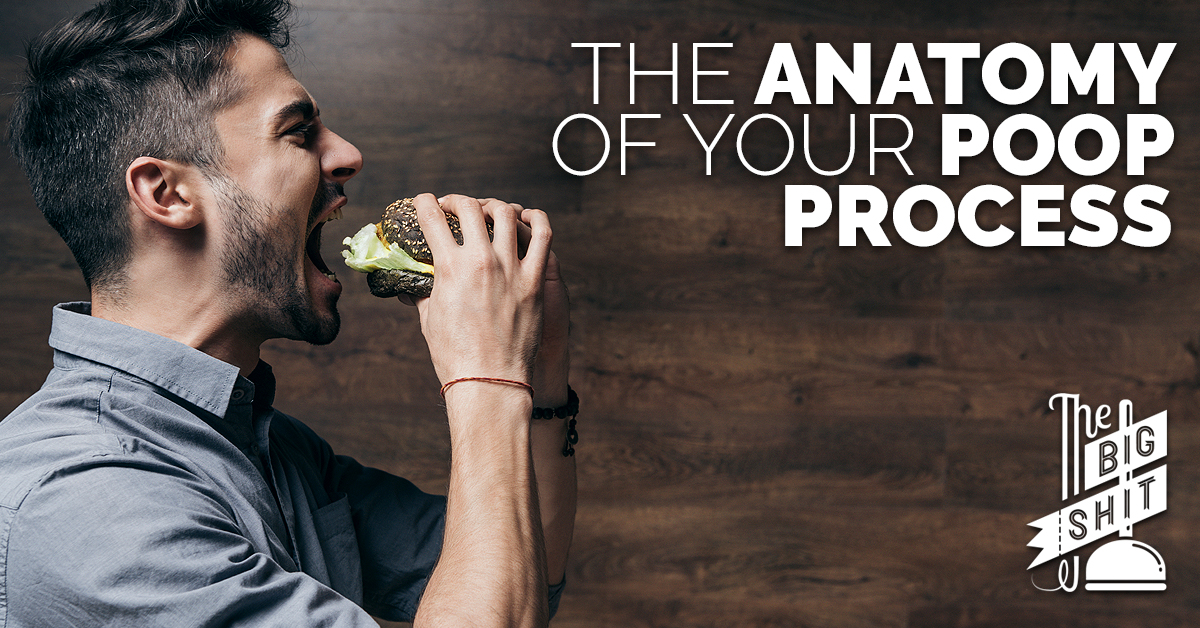
30 Jul The anatomy of your poop process, beginning to end!
Most of us don’t really think about the poop process much of the time, unless they are sitting on a cold toilet seat one morning pondering how it all happens. Well, you are in for a treat. Rather than wondering why your dating profile hasn’t gotten many hits or what you could be posting to social media, this is something you can think about next time you find yourself taking care of business.
A Complex Network of Systems
The human body is a fine-tuned machine, complete with several interacting systems of organs such as the endocrine system, cardiac tissue, waste filtering and processing, skin, and a nervous system to tie it all together, but it has only a few basic functions:
- Breathing
- Moving
- Reproduction
- Eating
- Processing everything it has eaten into poop,
Chewing and then Down to Your Stomach
The last one is called digestion. When we eat, we already begin the process of digesting our food. Our teeth cut and grind our food into smaller pieces, increasing the surface area for digestive fluids such as saliva which are created by glands in our bodies. Saliva, created by salivary glands in the mouth, helps the smaller pieces of food go down the esophagus, where the process of peristalsis pulls the food to the stomach. The liver and pancreas fill the gallbladder and stomach with bile and stomach acid, which also begin to break down the fiber and connective tissue the teeth only started to make a dent on. (Pun intended–“dent” is Latin for “tooth”). These powerful acids, emulsifiers and digestive juices break food down to where it can exit the stomach as more or less liquid.
The Small Intestine Suburb of the Large Intestine
After leaving the duodenum sphincter, a valve that keeps the compartment of the stomach free from the small intestine, it is there that more nutrients are extracted by the digestive process. Over 20 feet of small intestine, also known as the bowel continues to extract what is useful from this mash, winding back and forth through until it reaches the large intestine. This increases the surface area to capillaries, which carry digested food into your body for further processing elsewhere. There are also critters living in your gut that help out! Bacterium aid in digestion, in a symbiotic relationship that means they get whatever they want out of your digestion, and in turn they help break down the food and give you more useful stuff out of it!
By the time it reaches the large intestine, most of the useful part of the food has been absorbed into the body.
- Sugars
- Protien
- Fats
- Vitamins and Minerals
What remains is a slurry of solids and water that could not be absorbed by the blood vessels and capillaries that have run in and out of the gut so far. Your kidneys are only part of what filters and treats the water that enters your body. Your large intestine extracts the majority of it, pushing the non-soluble solids (such as fiber) onward using more peristalsis and eventually compacting the drier solids into what is more recognized as feces. Or poop!
Around five feet of large intestine work to dehydrate these solids and extract even more nutrients if possible. Many solids aren’t easily digestible, such as corn, beans, and fiber, but these solids also help move things along! Sometimes gas can build up in the large intestine, which escapes when you fart or “pass gas!”
This is How it All Comes Out
The end of the line is the rectum, which is a final chamber and a series of sphincter muscles, one being the anus, keep your poop together (and the outside world out) until your body senses it is time to eliminate it from the premises! This nervous system sensation alerts you that you need to go, and so you do (hopefully when appropriate or convenient). By this time there is nothing good left over that your body needs, and by now what is left over in poop might be very harmful. Which is why your anus serves a much better purpose being so far away from where food goes in. (This is why it is crucial to wash your hands after using the bathroom!)
So that is the long-story-short version of the digestive process. Beginning to um…end.
